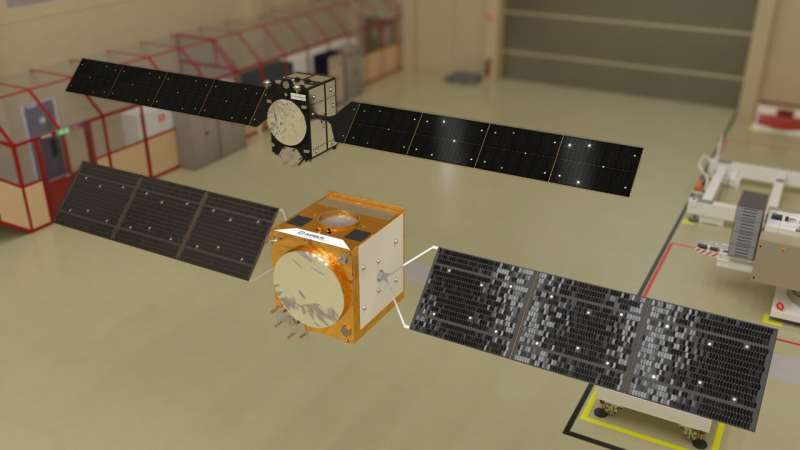This article has been reviewed according to Science X's editorial process and policies. Editors have highlighted the following attributes while ensuring the content's credibility:
fact-checked
trusted source
proofread
Green light for Galileo second-generation satellite design

Production of Galileo Second Generation satellites advances at full speed after two independent Satellite Critical Design Review boards have confirmed that the satellite designs of the respective industries meet all mission and performance requirements. This achievement is another crucial milestone hit on time in the ambitious schedule to develop the first 12 satellites of the Galileo Second Generation fleet.
The European Galileo navigation system, the most precise worldwide, is gearing up for the Second Generation (G2). G2 will bring unprecedented positioning, navigation and timing capabilities to support a wide array of user needs and services.
The Second Generation fleet will comprise two different satellite families that are being developed in parallel. Both models have recently been subject to in-depth assessment by the ESA-led Critical Design Review (CDR) boards. As part of the review, independent technical experts have verified the satellites' design robustness and technical capabilities.
The satellite CDR boards, with senior experts from ESA, EUSPA and the European Commission, confirmed that both Galileo Second Generation satellite designs are in accordance with the full mission profile, operable from the Galileo ground segment and compatible with the selected launcher vehicle, Ariane 6.
The first board met on 18 April to review the Thales Alenia Space satellite design, and the second gathered on 16 May to examine the design from Airbus Defense and Space. Both meetings took place at ESA ESTEC in the Netherlands, following preparatory meetings at the respective industry offices.
Eric Villette and Alberto Bramante, leading the management of the two G2 Space Segment contracts, describe the ESA CDR process. "It is structured around peer review panels led by independent technical experts from ESA specialized in satellite design," explains Villette. Bramante adds, "The review is based on design descriptions, analyses, test plans and test results made available by the industrial consortia."
Galileo Second Generation satellites will be groundbreaking: they will have fully digital navigation payloads, use electric propulsion, host a more powerful navigation antenna, have inter-satellite link capacity and an advanced atomic clock configuration. Moreover, their architecture will offer a high degree of flexibility.
G2 can now ramp up its production. Industry is already busy manufacturing all the onboard equipment and satellite structures, and the teams will begin assembling and integrating the components in the proto-flight models soon.
Additionally, in the coming months the first satellite compatibility test campaigns will validate the communication between the satellites and ground segment.
Head of the Galileo Program Office, Miguel Manteiga, thanked all the teams that participated in the satellite CDR process, "It is remarkable to see how, when faced with the most exigent requirements for GNSS satellite systems in history, European industry can answer in time to deliver a state-of-the-art design.
"We are really looking forward to ramping up manufacturing and to starting the System Compatibility Test campaigns with satellites, ground segment and Galileo receivers."
To this date, the Galileo constellation has 30 First Generation satellites in orbit and an additional eight are ready to be launched, two in September this year and six more starting in 2025. Second Generation launches will begin before the end of this decade.
About Galileo
Galileo is currently the world's most precise satellite navigation system, serving over four billion smartphone users around the globe since entering Open Service in 2017. All smartphones sold in the European Single Market are now guaranteed Galileo-enabled. In addition, Galileo is making a difference across the fields of rail, maritime, agriculture, financial timing services and rescue operations.
A flagship program of the EU, Galileo is managed and by the European Commission. Since its inception, ESA leads the design, development and qualification of the space and ground systems, as well as procuring launches.
ESA is also entrusted with research and development activities for the future of Galileo within the EU program Horizon Europe. The EU Agency for the Space Program (EUSPA) acts as the service provider, overseeing the market and application needs and closing the loop with users.
Provided by European Space Agency





















